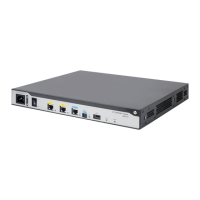
Do you have a question about the HP MSR1002-4 and is the answer not in the manual?
| Model | MSR1002-4 |
|---|---|
| Product Series | MSR1000 |
| Total Ports | 4 |
| VPN Support | Yes |
| Firewall | Yes |
| Wireless | No |
| Input Voltage | 100-240V AC |
| Power Consumption | 30W |
| Port Type | Ethernet |
| Ports | 4 x 10/100/1000Base-T |
| Additional Ports | 1 x Console |
| Power Supply | Internal |
| Operating Temperature | 0°C to 45°C |
Enables or disables debugging for modules, with options for timeout and specific module debugging.
Tests IP address reachability and displays statistics using ICMP echo requests.
Traces the path of packets from source to destination, identifying Layer 3 devices.
Configures NQA operations like advantage factor, codec type, and destination parameters.
Specifies the destination IP or IPv6 address for NQA operations.
Displays NQA operation history, reaction counters, and test results.
Displays detailed information about all IPv6 NTP associations.
Configures access control rights for peer devices accessing NTP services.
Enables NTP authentication to enhance network security and synchronize with authenticated servers.
Applies a PoE profile to a power interface (PI) or a range of PIs.
Displays general PSE information, including ID, slot, and status.
Configures power supply priority for PIs or PSEs to manage power allocation during overload.
Displays SNMPv1 or SNMPv2c community information, including group and ACL details.
Displays SNMP group information, including name, security model, MIB view, and storage-type.
Adds or deletes SNMPv1 or SNMPv2c users to/from groups, managing communities similarly to SNMPv3.
Captures incoming packets on an interface with options for filtering, limiting, and file storage.
Displays the contents of a captured packet file in various formats (raw, brief, verbose).
Displays entries in the RMON alarm table, showing owner, status, and thresholds.
Displays RMON event entries, including index, owner, description, and triggered actions.
Displays RMON history control entries and history samples of Ethernet statistics for interfaces.
Sets notification or set actions for events, defining OIDs and values.
Specifies the Boolean comparison type (equal, greater, less) for trigger conditions.
Displays Event MIB configuration and statistics, including trigger and event details.
Enables NETCONF messages encapsulated with SOAP in HTTP packets for device resolution.
Enables NETCONF over SSH, allowing XML messages for operations without the xml command.
Configures the password for authentication to the default ACS URL.
Specifies the interface used by the CPE for CWMP connection to the ACS.
Configures the username for CPE authentication to the ACS.
Adds a CLI action to a monitor policy, specifying command lines for event execution.
Configures an interface event for CLI-defined monitor policies based on traffic statistics.
Creates, binds, and deletes CLI-defined EAA monitor policies.
Displays context information for process exceptions, including PID and crash details.
Displays process state information, including CPU and memory usage.
Enables or disables kernel thread deadloop detection and configures parameters.
Displays configuration information for samplers, including mode and packet interval.
Creates or deletes a sampler, specifying mode (fixed/random) and sampling rate.
Displays mirroring group information, including type, status, and configured ports.
Creates or deletes mirroring groups and configures source/monitor ports.
Configures a mirroring action for a traffic behavior, specifying the destination interface.
Displays NetStream entry information, including flow statistics and packet size distribution.
Enables NetStream filtering on an interface using ACLs to identify specific flows.
Sets NetStream aggregation modes (AS, prefix, etc.) for data export.
Displays IPv6 NetStream entry information, including flow statistics and packet size distribution.
Enables IPv6 NetStream filtering on an interface using ACLs to identify specific flows.
Sets IPv6 NetStream aggregation modes (AS, prefix, etc.) for data export.
Displays sFlow configuration and operation information, including collector and port settings.
Configures the IP address for the sFlow agent, recommending manual IP address configuration.
Configures parameters for an sFlow collector, including IP, port, and description.
Manages diagnostic logs: saving, setting size quota, and specifying directory.
Displays a summary of the log buffer, showing counts for different severity levels.
Enables or disables saving diagnostic logs to the diagnostic log file.
Specifies log hosts and configures output parameters like port and facility.
Describes conventions for text formatting: boldface, italic, brackets, braces, and asterisk.
Explains conventions for graphical user interface elements: boldface for UI elements and angle brackets for menus.
Defines symbols like WARNING, CAUTION, IMPORTANT, NOTE, and TIP for alerts and information.